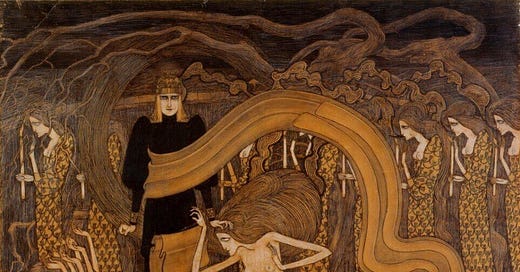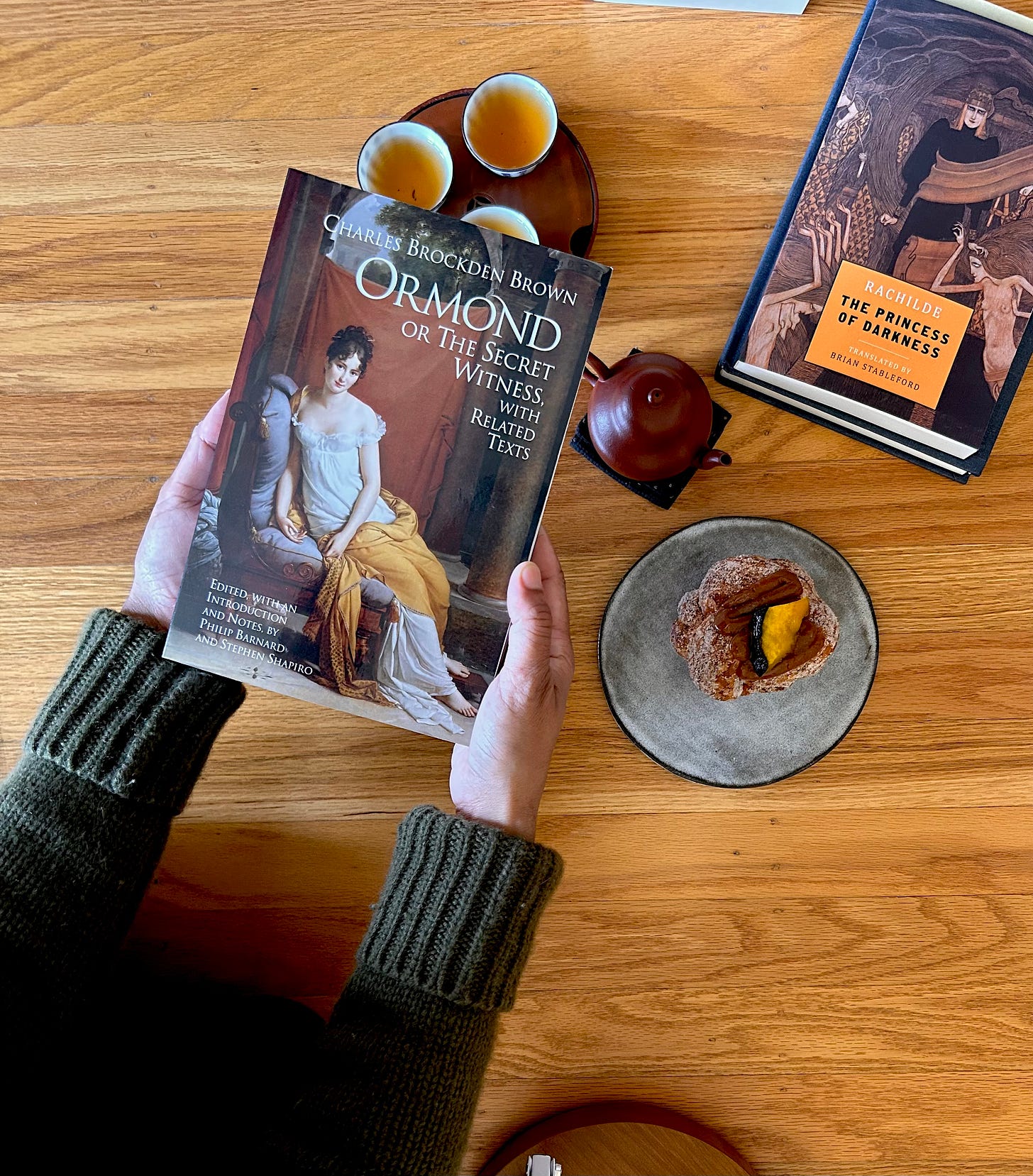Rachilde's The Princess of Darkness
A radical feminist gothic novel by an avowed anti-feminist
unknown literary canon is a reader-supported newsletter dedicated to preserving and archiving lesser known literary works, and especially, lesbian literature, poetry, art, and history. if you would like to support this project, please like, share, comment, and if you have the means, consider becoming a paid subscriber. Any and all form of support are deeply appreciated!
Rachilde, so discreet looking when you first meet her beneath her small cap decorated with strawberry flowers beneath her veil which is the color of distances …mermaid eyes shielded by two rows of steely eyelashes, which prevent humanity from entering too far into the realm of their folly.
Rachilde, who slashes a crowd with sarcasm, is gentle toward bats and white mice, looks after them and describes them with a maternal sense that she must hide from her apparent family. Her real family is a world underground and underwater from which she emerges, before suffocating, to scream at the top of her voice her rage against humans. 1
Fatalisme : Jan Toorop : 1893 (this is the cover art for the Snuggly books editions of Rachilde’s The Princess of Darkness, beautifully translated by Brian Stableford, book photographed and reviewed by me below)
Rachilde
Born Marguerite Vallette-Eymery, she took Rachilde as a pseudonym. She was an undoubtedly interesting character. She began writing for a local newspaper at the age of twelve, and her writing showed an awareness of decadent sensuality when she was fifteen. Rachilde would later be considered part of the Decadent movement, that late 19th European movement whose most famous writers include Gabrielle D’Annunzio and Charles Baudelaire. Her version of decadence was that of aesthetic sensuality and hedonism divorced from the sort of material splendor of D’Annunzio, but more extreme in sexuality and fantasy.
When she was twenty and (supposedly) still a virgin, she wrote Monsieur Venus (1884). It was tried for obscenity in Belgium, and Rachilde was sentenced to two (or five? sources vary) years in prison in absentia. It is about a woman, Raoule de Vénérande, who rejects a stereotypically masculine noble suitor and instead marries an androgynous florist. She puts the florist through a escalating series of humiliations, feminizing him while she cross-dresses. The noble ex-suitor challenges husband to a duel, husband is killed. Raoule makes a wax version of him, with his fingernails and hair, which she dresses alternatively in feminine and masculine clothes, and she kisses him every night. Remarkable: it was published in 1884, and the themes include necrophilia, gender role reversal, power given to and held by another, and the nature of sexual desire.
Now perhaps you, reader, understand why I added the interesting introduction about Rachilde. It captures so much about her: bizarre, very dark, highly questionable. Yet, there’s something about the whole thing that high black comedy, so fantastical and disconnected from reality that it becomes almost laughable, albeit in a mischievous way.
Monsieur Venus is Rachilde’s most famous book, and someone somewhere on the internet suggest I add it to my lesbian literary archive. However, Rachilde was adamant that she was not a lesbian nor a feminist. Women were, to her, inferior “brothers” of men, so much so that she called herself a “man of letter”2 and wrote a pamphlet “Why I am not a Feminist”. In the pamphlet, she said:
I always regretted not being a man, not so much because I value the other half of mankind but because, since I was forced by duty or by taste to live like a man, to carry alone the heavy burden of life during my childhood, it would have been preferable to have had at least the privileges if not the appearances.
Despite her distain for women and her marriage to a man, she had an affair with Gisèle d'Estoc. She was also friends with Natalie Barney and Oscar Wilde, and wrote articles defending homosexuality. She was not gender conforming, petitioning the local (French) government to be able to wear men’s clothing.
The Princess of Darkness
The Princess of Darkness (1895) is Rachilde-lite. It’s fantasy, and a gothic horror. All the tropes of the theme are there: the haunted country manor (set in the French countryside), the frail, sickly heroine who may or may not be losing her sanity, the older female antagonist who makes life unnecessarily difficult for the heroine. Her two suitors who are quite opposite: the good country doctor, and stunningly handsome brooding suitor.
Madeline grew up in France, and wound up in the French countryside with her father and widowed aunt. She’s twenty-two, few prospects: no dowry to make a decent marriage, no marketable skills, and what’s more, she’s pale, sickly, and, as her aunt tells her, people in the countryside will think her red hair is ugly. The cheerful, optimist doctor that is summoned slowly falls in love with her. He tells her, repeatedly, that he is a physician and not a man. He asks to marry her, promising to take care of her while doubting her sanity. She accepts, under one condition: that she be allowed to remain a virgin all her life, to stay the princess of darkness. He answers that he will wait as long as she needs to come around, then asks her if she loves children. Her other suitor, a mystery figure who appears under her bedroom window one night with an enormous, silent dog, is beautiful. Perhaps he is a ghost, perhaps the devil himself. When he asks for love, she says no, then tells him “I shall love you under one condition, which is that you forget that you’re a man and that I’m a woman.” The draw of her two lovers is clear, the trope reminiscent of that found in other gothic novels.
Rachilde goes beyond the gothic novel and leans into the theme common in her decadent roles: subverted gender roles and ask if love without sexuality and was possible. She asks her husband-to-be for eternal virginity, and the reader can discern his wishes. With her mysterious suitor, she asks herself:
Had she not dreamed once of loving a second self in order that their purely cerebral passion, having arrived at its paroxysm, would never have the right or the duty to descend to the brutal prostitutions of the flesh, which determined while luring the senses?
Madeleine asks for gender to be forgotten so that sexuality could be left behind, as the two are so inexorably linked as to be inseparable. Throughout, Rachilde reminds the reader of Madeleine’s frail (yet curvaceous) body, and her beautiful flame-colored hair, sometimes red as hellfire and other times nearer to gold. It’s a symbol of dark and light, of blood and fire, and of her femininity. Both of her suitors are fascinated by and drawn to it.
“Sometimes, in the middle of a dream, I see the three-legged wolf, it wakes me up with a start and I can’t go back to sleep. It’s a wolf that I saw for the first time as a little girl, during a fever…It limped, and held out its paw, which was crushed and streaming with black blood. It was abominable, but it caused me more pity than horror….
But there isn’t only the three-legged wolf, there’s also the game of anguished children, as we called it at school. Not being able to go back to sleep I lay down full length, with my arms pressed to my body and I held my breath; then I said to myself: ‘You’re condemned to death! In ten years, or twenty years, or perhaps in one year, you’re going to die. Since birth, the being you call the good God has condemned you to death; and I weep. It’s irresistible...” (p. 167-168)
In her rage against death, blood, men, sexuality, and a woman’s choices, reader, I questioned why Rachilde repeatedly said she wasn’t a feminist. The inference underlying Rachilde’s writing about the limitations of Madeleine’s choices is similar to, though far more furious, than the feminism that a reader encountered in Charlotte Brontë’s Jane Eyre (1847), the implication of the darkness of masculine attitudes toward women as Matthew Lewis’ The Monk (1796).
Yet, Rachilde goes further than Brontë and Lewis, and her attitudes wouldn’t be amiss in radical feminist circles today. Rachilde’s attitude toward men and sex remind me of the anti-pornography second-wave feminists that came much later: Andrea Dworkin (author of Pornography: Men Possessing Women (1981)) and Catharine MacKinnon, who, in Toward a Feminist Theory of the State, wrote that "Pornography contributes causally to attitudes and behaviors of violence and discrimination which define the treatment and status of half the population."3 The attitude toward sex, Madeleine’s dread and avoidance of it, the references to blood and violence, the implication of desire and violence by her suitors, read similarly in spirit, although written nearly a hundred years before MacKinnon’s. Instead of theorizing and telling as with Dworkin and MacKinnon, Rachilde seduces to show the reader the grotesque side of sexuality and the harms it causes to men and women.
If I were to draw only from The Princess of Darkness, I would theorize that Rachilde’s “anti feminism”, her teenage decadent writing, desire to leave behind some of the trappings of femininity and dress and live as a man, and in other works, to dominate men, might have a different root than a dislike of women4. Whatever the cause, The Princess of Darkness is a subversive, feminist gothic tale that’s remarkably ahead of its time and worth reading.
Barney, Natalie. Trans. and Annotations by Gatton, John Spalding. Adventures of the Mind. 1992. The Cutting Edge: Lesbian and Life Series, by New York University Press. p. 153.
I’m using feminine pronouns despite this because I don’t know what her gender identity was, and nor would she have known about our usage of pronouns (she died in 1953).
I was discussing MacKinnon with another lesbian/feminist substacker last week, and have promised to write about the book I quoted here.
Mackinnon, Catharine. Toward A Feminist Theory of The State. 1989. Cambridge, Massachusetts: Harvard.
There are various explanations I can think of: gender non-conformity, transgenderism, childhood sexual trauma. However, not enough is known about any of these to definitively say which or if all apply to Rachilde.







Thank you for the introduction to Rachilde! I’m going in search of both novels.
I am fascinated by authors who were willing to put their work into the world despite being tried and punished under obscenity laws. The current times have me wondering if I would be so brave or so confidently committed to my craft.
A complicated person. And so interesting!